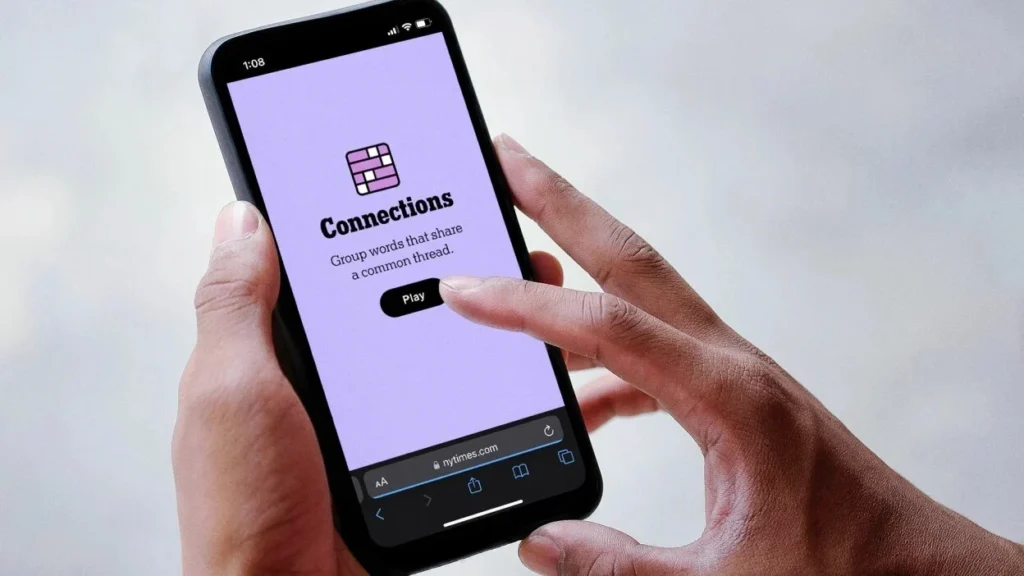
connections hint
introduction to connections hint
In today’s interconnected world, the concept of “connections” has expanded beyond simple physical or digital interactions. It now encompasses everything from personal relationships, professional networking, online presence, and the increasingly complex web of social dynamics. The phrase “Connections Hint Today” signals a modern understanding of how we link ourselves to others, whether in person or through technology. This article will explore the numerous facets of connections today, covering both digital and personal realms, offering insights on how to foster meaningful relationships, optimize digital networking, and leverage your connections for success.
1. Introduction: The Concept of Connections Today

Connections are more than just the bonds we form; they are the threads that weave through our lives, creating networks of relationships, influence, and opportunity. In today’s fast-paced, highly connected world, the way we build and maintain relationships has evolved dramatically. Gone are the days when connections were limited to geographic proximity or familial ties. Today, connections can be global, instantaneous, and diverse, spanning personal, professional, and digital realms. connections hint
The importance of connections today is multifaceted. Whether it’s your career, social standing, or emotional wellbeing, the strength of your relationships can significantly impact every aspect of your life. While the traditional handshake might still play a role in making a good first impression, the introduction of technology, especially social media platforms like LinkedIn, Facebook, and Instagram, has revolutionized how we connect, build relationships, and maintain them.
Furthermore, in a world where “who you know” can be just as critical as “what you know,” understanding the value of connections has never been more crucial. This article will explore how to navigate the complexities of today’s connected world, offering insights into personal and professional networking, the impact of digital relationships, and strategies for leveraging your connections for personal and career growth. connections hint
2. The Role of Technology in Modern Connections
Technology has fundamentally altered the way we form and nurture connections. The rise of the internet, social media, and communication platforms like Zoom and Slack have made it easier to connect with people across the globe, regardless of location. These digital tools have bridged gaps that once seemed insurmountable, enabling us to maintain friendships, collaborate professionally, and even form new relationships without ever meeting in person.
Social Media Networks
Social media networks are one of the most significant drivers of modern connections. Platforms like Facebook and Instagram have turned social networking into a global activity, allowing individuals to connect with friends, family, and strangers based on shared interests or mutual acquaintances. Twitter and TikTok further enhance this by providing real-time updates and interactions, which creates a sense of immediacy in our relationships. With social media, it is easier than ever to maintain a connection, even if that relationship is more casual or distant.
Online Platforms for Professional Growth
When it comes to professional connections, LinkedIn has become the go-to platform. What makes LinkedIn so valuable is its dual purpose: it’s both a professional networking tool and a portfolio. You can build your brand, showcase your skills, and connect with colleagues or industry leaders all in one place. Meanwhile, platforms like GitHub for developers or Behance for designers offer niche networking opportunities where professionals can showcase their work and connect with others in their field. This gives rise to a new kind of professional interaction that is driven by mutual interests and professional goals, as opposed to traditional in-person networking events.
The accessibility of these platforms makes connecting with people who can help advance your career as easy as sending a message or sharing a post. While technology has opened the doors to networking like never before, it’s important to understand how to use these tools effectively.
3. Types of Connections: Personal vs. Professiona
While the lines between personal and professional connections are often blurred, it’s essential to differentiate between the two and recognize how each type of connection contributes to our lives. Both personal and professional relationships are vital, but they serve different purposes and require different approaches.
Differentiating Personal and Professional Relationships
Personal connections are those we form with friends, family, and acquaintances with whom we share emotional bonds. These relationships provide support, comfort, and companionship. Professional connections, on the other hand, are built on mutual career interests. They are formed for the purpose of collaboration, networking, and career advancement. While personal connections can sometimes overlap with professional ones, it’s important to understand that the dynamics of these relationships differ greatly. For example, your professional relationship with a mentor is likely to be more formal and goal-oriented than your friendship with a childhood companion.
How to Balance Both
Balancing personal and professional connections can be challenging, especially when your work life starts to overlap with your personal life. To maintain this balance, it’s important to set boundaries. Avoid overextending yourself by managing your time wisely and ensuring that both personal and professional relationships get the attention they deserve. Additionally, consider that nurturing personal connections can often provide the emotional energy you need to excel in your professional life. Both types of connections should be seen as complementary, rather than competing aspects of your network.
By consciously managing both types of relationships, you can create a balanced network that provides support, growth, and opportunities.
4. Building Strong Personal Connections
Personal connections are essential for emotional well-being and a sense of belonging. In today’s fast-paced world, building and maintaining strong personal relationships requires effort, especially with the distractions of social media and the digital world.
Emotional Intelligence and Empathy
One of the most important factors in forming and sustaining strong personal connections is emotional intelligence. Emotional intelligence refers to the ability to understand and manage your emotions while also recognizing and responding to the emotions of others. People with high emotional intelligence are more empathetic, which allows them to build deeper and more meaningful relationships. Being able to listen actively, show genuine concern, and respond to the needs of others strengthens the trust and intimacy in personal connections.
Fostering Trust and Loyalty
Trust is the cornerstone of any strong personal connection. Without trust, relationships are fragile and can quickly break down. Building trust requires honesty, transparency, and consistency. It also involves keeping your word and being there for others when they need you most. Loyalty goes hand in hand with trust, as it demonstrates your commitment to the relationship, even when things get tough. By fostering trust and loyalty, you can build a network of personal connections that stand the test of time.
Creating Shared Experiences
Shared experiences, whether they’re casual hangouts or significant life events, are another key to strengthening personal connections. These moments help solidify bonds and create memories that serve as a foundation for long-lasting relationships. Make time for your friends and family by engaging in activities you both enjoy, whether it’s something as simple as a coffee date or a more elaborate group trip. In today’s world, where it’s easy to drift apart due to the distractions of everyday life, carving out time for shared experiences is more important than ever.
5. Professional Networking: Strategies for Success
Professional networking is critical for career growth and development. Building a strong professional network can lead to job opportunities, collaborations, mentorships, and partnerships. However, effective networking requires more than just attending events and collecting business cards—it requires intentionality and strategy.
Networking Events and Online Platforms
Attending industry-specific networking events is one of the most effective ways to build professional relationships. These events provide opportunities to meet individuals who share your career interests and can open doors to new job opportunities or collaborations. However, with the rise of online platforms like LinkedIn, networking has extended beyond in-person events. Online platforms offer the ability to connect with professionals across the globe, providing a broader connections hint
reach and more flexibility in terms of how and when you network. The key to success is being active on these platforms, sharing valuable content, and engaging with others regularly. connections hint
Maintaining Professional Relationships
Building a network is one thing; maintaining it is another. It’s important to stay in touch with your connections, even when you don’t need something from them. Send a congratulatory message when they reach a career milestone or simply check in from time to time. Maintaining a relationship is not just about what you can get, but also about what you can give. Be willing to offer your help and support when possible, as this will strengthen your relationships and demonstrate your value as a contact. connections hint
The Power of Mentorship
Mentorship is one of the most valuable forms of professional connection. A mentor can provide guidance, support, and insights that can help you navigate your career path more effectively. Whether you’re seeking a mentor or looking to become one, fostering this type of relationship can be incredibly beneficial. When done right, mentorship can lead to long-lasting professional relationships that provide mutual benefit and growth. connections hint
6. Digital Networking: Maximizing Online Presence
In today’s digital age, your online presence is just as important—if not more so—than your in-person presence. Digital networking allows you to connect with a wider audience, gain exposure, and build relationships that can advance your career or personal brand.
Social Media Influence
One of the most powerful tools in digital networking is social media. Platforms like LinkedIn, Twitter, and Instagram allow you to showcase your work, share your expertise, and engage with others in your industry. By curating a professional and engaging online presence, you can attract followers, potential collaborators, and even job opportunities. However, it’s important to be strategic about what you post and how you engage with others. Your online persona should reflect your goals, values, and professionalism. connections hint
Tools for Expanding Your Digital Network
Beyond social media, there are numerous tools available to help you expand your digital network. These include networking-specific platforms like Meetup or Eventbrite, where you can find events related to your interests or industry. Other tools like LinkedIn’s InMail feature or Twitter’s direct messaging can be used to reach out to individuals you admire or want to collaborate with. The key to digital networking is being proactive—don’t wait for connections to come to you. Reach out, engage in conversations, and participate in online communities related to your field. connections hint
Personal Branding Online
Your online presence is an extension of your personal brand. How you present yourself digitally can affect how others perceive you, so it’s important to be mindful of your online behavior. This includes everything from the type of content you share to how you interact with others on social media. Developing a strong personal brand online can lead to new opportunities and enhance your credibility within your industry. connections hint
7. The Psychology Behind Human Connections
Human beings are social creatures, and connections play a vital role in our mental and emotional well-being. Understanding the psychology behind how and why we form connections can help us foster stronger, more meaningful relationships. connections hint
How Connections Impact Mental Health
Connections have a profound impact on mental health. Having strong social relationships is associated with better mental health outcomes, including lower rates of depression and anxiety, and an increased sense of happiness and well-being. This is because relationships provide emotional support, a sense of belonging, and a buffer against stress. In contrast, loneliness and social isolation can lead to a decline in mental health, highlighting the importance of maintaining meaningful connections throughout life. connections hint
Understanding Social Capital
Social capital refers to the networks of relationships among individuals that provide support, resources, and access to opportunities. In other words, social capital is the value that comes from having a network of strong, supportive connections. People with high social capital often have more access to job opportunities, mentorship, and collaboration. Understanding the importance of social capital can encourage you to invest more time and effort into building and maintaining your relationships, both personal and professional. connections hint
The Need for Social Interaction
Human beings have an inherent need for social interaction, and this need can affect how we approach relationships. Studies show that people who engage in regular social activities tend to be happier and live longer than those who are isolated. This need for connection is why people gravitate towards social platforms and in-person interactions alike. Understanding this psychological drive can help you prioritize connections in your life, ensuring that you’re nurturing relationships that contribute to your overall well-being. connections hint
8. The Importance of Face-to-Face Interactions in a Digital World
While technology has made it easier to connect with others, nothing can replace the value of face-to-face interactions. In-person meetings allow for deeper connections and more meaningful relationships, as they provide the opportunity for real-time, genuine communication. connections hint
Balancing Digital and Real-Life Connections
In today’s fast-paced, technology-driven world, it’s easy to rely solely on digital connections. However, research shows that face-to-face interactions are critical for building trust, empathy, and emotional bonds. While it’s convenient to send a message or email, making the effort to meet in person can create a stronger, more lasting connection. The key is to find a balance between maintaining your digital network and nurturing your real-life relationships. Aim to complement your online interactions with face-to-face meetings whenever possible. connections hint
Making a Lasting Impact in Person
When you meet someone in person, you have the opportunity to leave a lasting impression that goes beyond words on a screen. Non-verbal cues like body language, tone of voice, and eye contact play a significant role in how others perceive you. These cues are difficult to convey through digital communication, which is why in-person meetings are so valuable. Whether it’s a professional event or a personal gathering, take the time to be fully present, listen actively, and engage meaningfully with others. connections hint
The Power of Presence
Presence is about more than just being physically present; it’s about being mentally and emotionally engaged in the moment. In a world full of distractions, practicing mindfulness during face-to-face interactions can make a huge difference in the quality of your relationships. By giving others your full attention, you demonstrate respect and value for the relationship, which strengthens your connection. connections hint
9. Leveraging Social Media for Meaningful Connections
Social media is often criticized for fostering shallow, superficial relationships. However, when used strategically, these platforms can be powerful tools for building meaningful, lasting connections. connections hint
Social Media Best Practices
To get the most out of social media, it’s important to approach it with intention. Instead of mindlessly scrolling through your feed, focus on engaging with content that aligns with your interests or professional goals. Comment thoughtfully, share valuable insights, and reach out to individuals whose work you admire. By being intentional about how you use social media, you can build a network of meaningful connections rather than superficial ones. connections hintconnections hint
Avoiding Superficial Connections
One of the biggest pitfalls of social media is the tendency to form connections that lack depth or substance. Collecting friends or followers for the sake of boosting numbers doesn’t lead to meaningful relationships. Instead, focus on quality over quantity. Engage in meaningful conversations, follow people who inspire or challenge you, and invest time in building genuine relationships with those who share your values or goals. connections hint
Building a Community Online
Social media also provides the opportunity to build or join communities that align with your interests or career goals. By participating in online communities, you can connect with like-minded individuals, share ideas, and gain support. Whether it’s a professional group on LinkedIn or a hobby-focused community on Facebook, these spaces allow you to build meaningful connections with people who share your passions. connections hint
10. Navigating Online Professional Networks (e.g., LinkedIn)
Online professional networks like LinkedIn offer incredible opportunities for career growth, but navigating these platforms effectively requires a clear strategy. connections hint
How to Optimize LinkedIn for Professional Growth
LinkedIn is more than just a digital resume—it’s a platform for networking, personal branding, and career advancement. To optimize your LinkedIn profile, ensure that it is complete, up-to-date, and reflective of your career goals. Use a professional photo, write a compelling summary, and highlight your skills and accomplishments. Regularly post updates, articles, or insights related to your industry to position yourself as a thought leader. Additionally, engage with others by commenting on their posts or sending personalized messages to start a conversation. connections hint
Dos and Don’ts of Online Networking
When networking online, it’s important to be respectful and professional in your interactions. Personalize your connection requests by explaining why you want to connect, rather than sending generic invitations. Avoid immediately asking for favors—build a relationship first by offering value or sharing insights. Be mindful of your tone in messages, as it can be easy for written communication to come across as overly formal or insincere. Finally, always follow up after a successful networking interaction to keep the connection alive.connections hint
Building an Engaged Network
An engaged network is one where members actively support, interact with, and provide value to each other. To build an engaged network, regularly contribute by sharing articles, posting questions, or offering advice. By staying active and engaged, you increase your visibility and demonstrate your commitment to the professional community. connections hint
11. The Power of Weak Ties in Networking
While most people focus on building strong, close-knit relationships, research shows that weak ties—casual acquaintances or distant connections—are often more valuable when it comes to professional growth. connections hint
Why Weak Ties Matter More Than Close Connections
Weak ties provide access to new information, ideas, and opportunities that may not be available within your immediate network. These connections can introduce you to new job opportunities, partnerships, or insights that you wouldn’t have encountered otherwise. Because weak ties move in different circles than close friends or colleagues, they are more likely to provide novel opportunities that can help advance your career.





